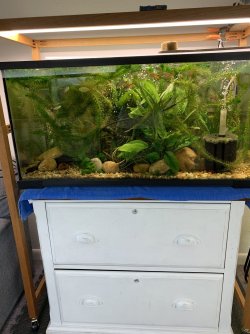PygmyPepperJulli
Fish Crazy
Hi,
Am wondering about cycling my new 52 gal tank (brand petworx). This tank was the cracked tank that is now unusable. I would like it to be in use as soon as possible, however am wondering the best way to do it.
1. I don't currently have any test strips. I was recommended some, however they're only on amazon.com without the .au, so would have to pay for likely excessive shipping. I was looking at these- https /www.amazon.com.au/Aquarium-Freshwater-Saltwater-Thermometer-Accurate/dp/B0BX6RN8NT/ref=sr_1_7?crid=1QNOPMDUCGLPU&keywords=JNW+aquarium+test+strips&qid=1701388296&sprefix=jnw+aquarium+test+strips,aps,310&sr=8-7&th=1 does anyone have any experience? I know the master test kit is better, but it needs to be cheap. I would love to just not have them, but is there any way to cycle with no test strips?
/www.amazon.com.au/Aquarium-Freshwater-Saltwater-Thermometer-Accurate/dp/B0BX6RN8NT/ref=sr_1_7?crid=1QNOPMDUCGLPU&keywords=JNW+aquarium+test+strips&qid=1701388296&sprefix=jnw+aquarium+test+strips,aps,310&sr=8-7&th=1 does anyone have any experience? I know the master test kit is better, but it needs to be cheap. I would love to just not have them, but is there any way to cycle with no test strips?
2. The cracked tank was halfway through cycling when it became unusable (I believe it was nearly there, but I don't actually know because I don't have test strips). I moved the substrate (rock, some sand will be put on top soon) and the filter that was running in there into the new aquarium, so will that kickstart the cycle since some bb would already be in there?
3. I am considering doing a fish-in cycle (the right way, only adding a few fish at a time, doing large water changes, etc. The only things that would be going in to cycle are either some fish from my pond, which are literally invincible, or my tetras, however they are slightly more sensitive). However, I know that there are lots of risks to the fish, so probably not. Maybe a plant cycle? Haven't decided (I have read all the cycling articles).
4. I want to buy as little stuff as possible (or none). This includes bottled bacteria such as Dr Tim's, or bottled ammonia, or (as mentioned earlier) really cheap test strips.
I'm mostly just looking for advice as this is the second tank I have cycled and the first one was ages and ages ago, and was a lot smaller. Thanks.
Am wondering about cycling my new 52 gal tank (brand petworx). This tank was the cracked tank that is now unusable. I would like it to be in use as soon as possible, however am wondering the best way to do it.
1. I don't currently have any test strips. I was recommended some, however they're only on amazon.com without the .au, so would have to pay for likely excessive shipping. I was looking at these- https
 /www.amazon.com.au/Aquarium-Freshwater-Saltwater-Thermometer-Accurate/dp/B0BX6RN8NT/ref=sr_1_7?crid=1QNOPMDUCGLPU&keywords=JNW+aquarium+test+strips&qid=1701388296&sprefix=jnw+aquarium+test+strips,aps,310&sr=8-7&th=1 does anyone have any experience? I know the master test kit is better, but it needs to be cheap. I would love to just not have them, but is there any way to cycle with no test strips?
/www.amazon.com.au/Aquarium-Freshwater-Saltwater-Thermometer-Accurate/dp/B0BX6RN8NT/ref=sr_1_7?crid=1QNOPMDUCGLPU&keywords=JNW+aquarium+test+strips&qid=1701388296&sprefix=jnw+aquarium+test+strips,aps,310&sr=8-7&th=1 does anyone have any experience? I know the master test kit is better, but it needs to be cheap. I would love to just not have them, but is there any way to cycle with no test strips?2. The cracked tank was halfway through cycling when it became unusable (I believe it was nearly there, but I don't actually know because I don't have test strips). I moved the substrate (rock, some sand will be put on top soon) and the filter that was running in there into the new aquarium, so will that kickstart the cycle since some bb would already be in there?
3. I am considering doing a fish-in cycle (the right way, only adding a few fish at a time, doing large water changes, etc. The only things that would be going in to cycle are either some fish from my pond, which are literally invincible, or my tetras, however they are slightly more sensitive). However, I know that there are lots of risks to the fish, so probably not. Maybe a plant cycle? Haven't decided (I have read all the cycling articles).
4. I want to buy as little stuff as possible (or none). This includes bottled bacteria such as Dr Tim's, or bottled ammonia, or (as mentioned earlier) really cheap test strips.
I'm mostly just looking for advice as this is the second tank I have cycled and the first one was ages and ages ago, and was a lot smaller. Thanks.
Last edited:


